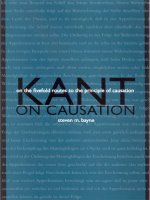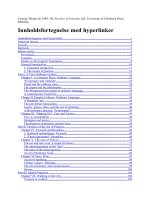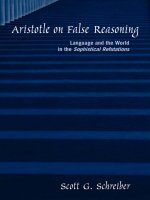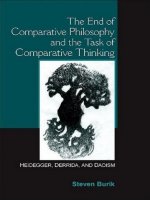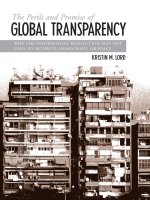university of the west indies press the earliest inhabitants the dynamics of the jamaican taino jul 2006
Bạn đang xem bản rút gọn của tài liệu. Xem và tải ngay bản đầy đủ của tài liệu tại đây (1.59 MB, 232 trang )
The Earliest Inhabitants
The Dynamics of the Jamaican Taíno
Edited by
Lesley-Gail Atkinson
The Earliest
Inhabitants
University of the West Indies Press
Jamaica • Barbados • Trinidad and Tobago
University of the West Indies Press
1A Aqueduct Flats Mona
Kingston 7 Jamaica
www.uwipress.com
© 2006 by Lesley-Gail Atkinson
All rights reserved. Published 2006
10 09 08 07 06 5 4 3 2 1
CATALOGUING IN PUBLICATION DATA
Earliest inhabitants: the dynamics of the Jamaican Taíno / edited by
Lesley-Gail Atkinson
p. cm.
Includes bibliographic references.
ISBN: 976-640-149-7
1. Taino Indians – Jamaica – Antiquities. 2. Indians of the West Indies – Jamaica –
Antiquities. 3. Taino Indians – Jamaica – Ethnobotany. 4. Excavations (Archaeology) –
Jamaica. 5. Indian pottery – Jamaica. 6. Jamaica – History. I. Atkinson, Lesley-Gail.
F1875.E37 2006 972.92
Cover illustration: Anna Ruth Henriques, Cocoa Zemi (2006).
Reproduced with kind permission of the artist.
Book and cover design by Robert Harris.
E-mail:
Set in AdobeCaslon 10.5/14.5 x 27
Printed in the United States of America.
This book is dedicated to two men who have
influenced my life tremendously.
In loving memory of my
grandfather, Ernest Aaron Adair,
for loving me unconditionally, and for teaching me
the significance of laughter. In my heart you’ll always
be “my favourite guy”!
and
Dr James W. Lee, founder and past president
of the Archaeological Society of Jamaica,
for your decades of contribution to
Jamaican archaeology, and for your
initiative and extensive research, which laid the
foundations for Jamaican prehistoric archaeology.
Thank you!
List of Illustrations / ix
List of Tables / xii
Preface / xiii
Acknowledgements / xv
Introduction / 1
Section 1 Assessment and Excavation of Taíno Sites
1 The Development of Jamaican Prehistory / 13
William F. Keegan and Lesley-Gail Atkinson
2 The Taíno Settlement of the Kingston Area / 34
Philip Allsworth-Jones, Gerald Lalor, George Lechler,
Simon F. Mitchell, Esther Z. Rodriques and Mitko Vutchkov
3 The Pre-Columbian Site of Chancery Hall, St Andrew / 47
Philip Allsworth-Jones, Anthony Gouldwell, George Lechler,
Simon F. Mitchell, Selvenious Walters, Jane Webster
and Robert Young
4 Excavations at Green Castle, St Mary / 69
Philip Allsworth-Jones and Kit Wesler
5 The Impact of Land-Based Development on Taíno
Archaeology in Jamaica / 75
Andrea Richards
Section 2 Taíno Exploitation of Natural Resources
6 Notes on the Natural History of Jamaica / 89
Wendy A. Lee
Contents
7 The Exploitation and Transformation of Jamaica’s
Natural Vegetation / 97
Lesley-Gail Atkinson
8 Early Arawak Subsistence Strategies: The Rodney’s House
Site of Jamaica / 113
Sylvia Scudder
Section 3 Analysis of Taíno Archaeological Data
9 Petrography and Source of Some Arawak Rock
Artefacts from Jamaica / 131
M. John Roobol and James W. Lee
10 Jamaican Taíno Pottery / 146
Norma Rodney-Harrack
11 Jamaican Redware / 153
James W. Lee
12 Taíno Ceramics from Post-Contact Jamaica / 161
Robyn P. Woodward
Section 4 Taíno Art Forms
13 The Petroglyphs of Jamaica / 177
James W. Lee
14 Zemís, Trees and Symbolic Landscapes:
Three Taíno Carvings from Jamaica / 187
Nicholas Saunders and Dorrick Gray
References / 199
Contributors / 214
viii
A.1 Map of the sites mentioned in the text / 4–5
1.1 Irving Rouse’s chronology of the series and subseries of
cultures in the West Indies / 21
1.2 Ostionan pottery from Jamaica / 23
1.3 Chican pottery from Hispaniola / 23
1.4 Jamaican Meillacan boat-shaped vessel / 24
1.5 Meillacan pottery from Haiti / 24
1.6 Local styles in the Ostionan, Meillacan and
Chican subseries / 25
2.1 Taíno sites in the Kingston area / 35
2.2 Histograms of the major elements in the pottery
samples compared with the levels in the soils from the
Kingston area / 43
3.1 Taíno skulls in situ / 48
3.2 Earthenware pot containing infant remains / 48
3.3 Beads associated with the skull / 49
3.4 JNHT excavations at Chancery Hall / 52
3.5 Stratigraphy of Chancery Hall / 56
4.1 Location of Green Castle / 70
4.2 Green Castle contour map / 71
4.3 Burial 1 / 73
4.4 Burial 2 / 73
5.1 Road cutting through Taíno site at Barbican, Hanover / 80
5.2 Road cutting through a portion of the Toby Abbott
Taíno site / 81
5.3 Chancery Hall Taíno site, St Andrew / 83
5.4 Long Mountain prior to development / 84
5.5 Construction activity at the Long Mountain site / 84
6.1 Jamaican hutia or coney / 95
ix
Illustrations
6.2 Hawksbill turtle / 95
7.1 Fernández de Oviedo’s illustration of Taínan caney / 101
7.2 Dugout canoe from Black River, St Elizabeth / 102
7.3 William Keegan explaining the use of the wild cane / 103
7.4 Two-notched net sinkers / 104
7.5 Four-notched net sinkers / 104
7.6 The annatto plant / 104
7.7 Members of the Paradise Park 2001 excavations measuring
the Ceiba tree / 112
9.1 Simplified geological map of Jamaica showing parishes / 134
10.1 Redware, White Marl and Montego Bay styles / 147
10.2 Normal boat-shaped vessel / 148
10.3 Round vessel / 149
10.4 Handled Taíno bowl / 150
10.5 Handles, lugs and decorative motifs / 150
10.6 Taíno bowl with hourglass-type handle / 151
10.7 Laterally perforated handle / 151
10.8 Ribbon decoration / 151
10.9 Cross-hatch decoration / 152
11.1 Map of Jamaican Redware sites / 154
11.2 Burén rim profiles / 156
11.3 Type I handles – plain “D” handles / 157
11.4 Type II handles / 157
11.5 Type III handles / 158
11.6 Other handle variations / 158
12.1 Map of St Ann’s Bay, Jamaica / 162
12.2 Distribution of New Seville and Taíno ceramics / 165
12.3 Meillac ware: (a) boat-shaped vessel; (b) round bowl / 166
12.4 Rim profiles / 167
12.5 Decorated rim sherds / 167
12.6 Spouted bowl / 168
12.7 Taíno water bottle / 168
12.8 New Seville ware bowls / 169
12.9 New Seville ware: (a) pitcher; (b) pedestal cup / 170
12.10 New Seville ware: (a) cup; (b) spout jug / 170
12.11 New Seville ware: jug / 171
12.12 New Seville pedestal cup / 171
13.1 Map of cave art sites / 178
x
I LLUSTRATIONS
13.2 Petroglyphs from Coventry and Cuckold Point / 180
13.3 Petroglyphs from Gut River No. 1 / 180
13.4 Petroglyphs from Reynold Bent, Milk River and
near God’s Well / 180
13.5 Petroglyphs at Canoe Valley / 181
13.6 Petroglyphs at Canoe Valley / 181
13.7 Pictographs at Spot Valley / 183
14.1 Anthropomorphic figure from Aboukir (detail) / 188
14.2 Anthropomorphic figure from Aboukir / 188
14.3 Bird figure from Aboukir (frontal view) / 189
14.4 Bird figure from Aboukir / 189
14.5 Carved wooden zemí of a bird standing on the back of
a turtle or tortoise / 189
14.6 Small ladle/spoon with anthropomorphic handle,
from Aboukir / 190
14.7 Small ladle/spoon with anthropomorphic handle,
from Aboukir / 190
14.8 Carved wooden duho stool, Dominican Republic / 192
xi
I
LLUSTRATIONS
1.1 Midden Sites Reported by Robert Howard / 30
1.2 Cave Sites Reported by Robert Howard / 32
1.3 Cave Art Sites Reported by Robert Howard / 33
2.1 Shells Collected from Chancery Hall / 39
2.2 Neutron Activation Analysis of Pottery Samples / 42
2.3 Taíno Sites in the Kingston Area / 45
3.1 All Recovered Organic Materials / 60
3.2 Size Distribution of Charcoal Fragments / 60
3.3 Arthropod Remains / 61
3.4 All Bone / 63
3.5 Fish Bone / 64
3.6 Mammalian Bone / 65
5.1 Examples of Threats to Taíno Sites / 75
5.2 Recorded Number of Destroyed Taíno Sites in Jamaica
by Parish / 76
6.1 Geologic Time and Corresponding Events in the
Formation of the Island of Jamica / 90
6.2 Main Soil Types of Jamaica and Associated Landforms / 91
6.3 Total Number of Species / 94
6.4 Numbers of Endemic Species / 96
8.1 Significant Vertebrate and Crab Remains from the Rodney’s
House Site / 117
8.2 Faunal Comparisons / 123
8.3 Rodney’s House Faunal List / 125
9.1 Lithology of Arawak Petaloid Celts from Jamaica / 135
9.2 Lithology of Petaloid Celts from Some Parishes
of Jamaica / 142
13.1 New Petroglyph/Pictograph Sites, 1952–1985 / 179
13.2 Jamaican Petroglyph Sites by Parish / 185
xii
Tables
I HAVE ALWAYS been fascinated by prehistory. Even though I
am a public archaeologist – and our research ranges from prehistoric settle-
ments to World War II hangars – I have an unapologetic bias towards Taíno
archaeology. I do not know if it is because my first dig was on a prehistoric site
or because my maternal ancestors were Maroons, who are said to have inte-
grated with the Taínos. Regardless of the reason, Taíno archaeology has
become one of my special interests.
The idea for this publication originated in 1998, when I was an assistant
curator in the Museums Division at the Institute of Jamaica. I had recently
been assigned the project of refurbishing the Taíno Museum at White Marl,
St Catherine. During my research for the museum, I uncovered a lot of data
on Jamaican prehistory – much of it unpublished and unfortunately not acces-
sible to the public at large. I felt that a book on Jamaican prehistory was long
overdue.
Three years later, I was employed as an archaeologist at the Jamaica
National Heritage Trust. As a consequence of my job, I faced constant com-
plaints from Jamaicans, overseas archaeologists and enthusiasts about the
inadequacy of publications on Jamaican archaeology. In addition, there were
frequent questions as to whether there was any research being done on the
island. I realized that the public was generally unaware. I knew that different
projects were taking place, and I was allowed to participate in many of them,
but that was mainly as a result of my job. I strongly believe that archaeology
belongs to the public and not solely to archaeologists. The knowledge and
the artefacts do not belong to the Jamaica National Heritage Trust or the
Institute of Jamaica, but to the people of Jamaica. It is their heritage.
Jamaicans are very proud. Like a real Jamaican, I took my pride – and at
times my embarrassment – and decided to undertake this ambitious project. I
thought an edited volume would be ideal, as it would give various archaeolo-
gists an opportunity to discuss their research projects. I formulated a proposed
structure for the text and contacted various people locally and overseas. I am
happy to say that most of them liked the idea and were glad to contribute to
xiii
Preface
the publication. The project took almost fifteen months to complete, and at
times I felt my ambition almost outdid me. This volume does not pretend to
be a comprehensive depiction of Jamaican prehistory, but it is a starting point,
and it aims to fill some of the gaps in Jamaican archaeology.
Lesley-Gail Atkinson
xiv
P REFACE
I WOULD FIRST like to express my gratitude to all the contrib-
utors to this publication: Philip Allsworth-Jones, Dorrick Gray, William F.
Keegan, Gerald Lalor, George Lechler, James W. Lee, Wendy A. Lee, Simon
F. Mitchell, Andrea Richards, Norma Rodney-Harrack, M. John Roobol,
Esther Z. Rodriques, Nicholas Saunders, Sylvia Scudder, Mitko Vutckhov,
Selvenious Walters, Kit Wesler and Robyn Woodward. I would especially
like to thank Philip Allsworth-Jones and my “left hand”, Andrea Richards,
who were tremendously supportive throughout the entire process. There are
several people – Debra-Kay Palmer, Basil Reid, Betty Jo Stokes and Peter
Harris – who were asked to contribute to the text but were unable to do so
for various reasons; nevertheless, I would like to thank them for their support
of the project.
The text includes six reprinted articles; therefore, permission had to be
obtained from various organizations. I thank the Anthropological Research
Papers, Arizona State University; La Fundación Arqueológica, Antropológica
e Histórica de Puerto Rico; Antiquity; the Archaeological Museum of Aruba;
and the Archaeological Society of Jamaica. I would like to specifically
acknowledge Emily Lundberg, Arminda Ruiz, Raymondo Dijkhoff and Jay
Haviser of the International Association of Caribbean Archaeology for their
assistance. I am also grateful to the Institute of Jamaica, the Jamaica Bauxite
Institute and the Archaeological Society of Jamaica for their permission to
publish and reprint several photographs and illustrations.
Several people have been extremely helpful, providing insight, advice and
assistance, in particular Ambassador Peter King, Verene A. Shepherd, James
Robertson, Patrick Bryan, F. Roy Augier, Marlon Manborde and John
Thaxter. Special thanks to the invaluable Karen Spence and the incredible
Ainsley Henriques. In addition, I would like to thank Dayne Buddho, Lauris
Codlin and Tyrone Barnett of the Institute of Jamaica for their assistance. I
must acknowledge the support of my other “family”, the staff of the
Archaeology Division of the Jamaica National Heritage Trust, in particular
Audene Brooks, Ann-Marie Howard-Brown, Rosemarie Whittaker, Colleen
xv
Acknowledgements
McGeachy, Michelle Topping, Ava Tomlinson, Evelyn Thompson, Jasinth
Williams and June Heath.
I am gratefully indebted to Linda Speth, Shivaun Hearne, Dionne
Williams, Claudette Upton and the team at the University of the West Indies
Press for their interest, patience and assistance throughout this project. A
renowned Jamaican politician once said that “it takes cash to care”; funding is
necessary for any publication, and this book is no exception. I would like to
take this opportunity to thank my sponsors,the City of Kingston Cooperative
Credit Union, the Shipping Association of Jamaica and Karen Adair. Without
their contributions this publication would not have been a reality.
I wish to acknowledge my family for their encouragement and tolerance
during this endeavour: my grandmother Dorothy Adair, my aunts Karen
Adair and Millicent Lynch, my father, Lodric Atkinson, and my mother,
Annette Adair-Hill. Finally, grateful thanks to my friends and special cheer-
leading squad – Tyrone Grandison, Andree Holness, Gifford Rankine,
Cherena Forbes, Howard Dawkins, Susan Chung and Velmore Coke.
xvi
A CKNOWLEDGEMENTS
IN JAMAICA, THE
indigenous population is still being referred
to as the Arawaks, despite the adoption of the term Taínos to distinguish the
native population of the Greater Antilles from the Arawaks of South
America. Irving Rouse defines the Taínos as “the ethnic group that inhabited
the Bahamian Archipelago, most of the Greater Antilles, and the northern
part of the Lesser Antilles prior to and during the time of Columbus” (1992,
185).
According to Rouse, in Columbus’s time the Taínos lacked an overall
name. The people referred to themselves by the names of the localities in
which they lived – for example, the Puerto Ricans called themselves
Borinquen, their name for the island, and the Bahamians called themselves
Lucayo (Rouse 1992, 5).This raises the question of what was the Taínan name
for Jamaica. Traditionally Jamaicans have been taught that Xaymaca was the
Taíno name given to the island, meaning “land abounding with springs”, from
which “Jamaica” – land of wood and water – was derived. However, D.J.R.
Walker suggests Yamaye as the possible Taíno name for the island, based on
information derived from Columbus’s journal (1992, 236–37).
The Arawaks or Taínos
The term Arawaks has been, and still is, mistakenly used to denote the aborig-
ines of the Greater Antilles and the Bahamas. The Arawaks were the ethnic
group that lived in the northern part of the Guianas, which formerly extended
onto the high land around the Orinoco delta (Rouse 1992, 173). According to
John Peter Bennett, the Arawaks had names for themselves and their lan-
guage, Lokono and Loko respectively (Bennett 1989, iv). For decades the terms
Arawak and Taíno have been used interchangeably; however, they are two
distinct ethnic groups.
It is not clear when the confusion occurred. However, one contributing fac-
tor was the attribution of the name of a language family to an ethnic group
(Rouse 1987). The Taínan language is said to belong to the Arawakan
1
Introduction
language family tree. According to Rouse, linguists now believe that the
Taíno, Island-Carib and Arawak languages diverged from the main line of
Arawakan development at the same late date and that all three belong in the
Maipuran subfamily (Rouse 1986, 120–23; Oliver 1989, 105).
Previously the Taínos were referred to as Island Arawaks; in fact, D.J.R.
Walker still uses this term (1992). Rouse demonstrates that this is another
source of the misnomer:
Daniel G. Brinton (1871) preferred to call the group Island Arawak because it
shared many linguistic and cultural traits with the Arawak Indians (also known
as Lokonos), whose descendants still live in northeastern South America. His
followers shortened the phrase to Arawak. That was a mistake. (1992, 5)
In the essay, “On the Meaning of the Term Arawak”, Rouse (1972) argues
that neither Columbus nor any of his counterparts came across the word
Arawak: “These Indians in the Greater Antilles are now known as ‘Arawaks’,
but they themselves did not use that name, nor did Columbus and his con-
temporaries ever come across it, as far as it is known.” Rouse adds that Arawak
does not appear in the literature until the exploration of the Guianas that
began in the late 1500s, almost a century after the arrival of Columbus in the
New World.
Centuries later, in 1894, Juan Lopez de Velasco noted the presence of peo-
ple who called themselves Arawaks on the Guiana coast, southeastern
Trinidad, and commented that a group of them had “intruded” into Trinidad.
Sir Walter Raleigh confirmed these statements and in 1928 included the
Aruacos in a list of five Indian “nations” that inhabited Trinidad ( Jane 1988).
Ethnohistorians merged the groups of people who inhabited the Greater
Antilles into one group – the Taíno – as they shared a single language and had
the same culture (Rouse 1992, 5). Taíno, which means “good” or “noble”, was
chosen because several of its members spoke that word to Columbus to indi-
cate that they were not Island Caribs (Alegría 1981). Andres Bernaldez
explains:
On the day when they came down the coast, there were many men and women
together, on the shore near the water, wondering at the fleet and marvelling
greatly at a thing so novel, and when a boat came to shore to have speech with
them they said, “Taínon, Taínon,” “good, good”. (Jane 1988)
Since the 1980s the term Taínos has been accepted in Caribbean archaeol-
ogy. In his article “Whom Did Columbus Discover in the West Indies?”
Rouse (1987) suggested that the commonly used name Arawak be replaced
with the name Taínos when discussing native West Indians at the time of
contact.
It is important to note that throughout this volume, the reader will
2
T HE E ARLIEST I NHABITANTS
encounter the term Arawaks used to describe the Jamaican Taíno culture.
These references are presented in their original context, as most of the litera-
ture assumed that the indigenous population of Jamaica was Arawak.
The Jamaican Taínos
It is believed that Jamaica was colonized after
AD 600 by ancestors of the
Taíno, the Ostionoid culture (Rouse 1992). At present, two of the earliest
known sites on the island are Little River, St Ann, and Alligator Pond
(Bottom Bay), Manchester, dated
AD 650 ± 120 (Vanderwal 1968a) (see
Figure A.1, nos. 89 and 4). These sites have been characterized as belonging
to the Ostionan Ostionoid subseries (Rouse 1992) or, as it is called locally,
Redware – a name reflecting its bright red ceramics. James W. Lee has pub-
lished articles on the Redware culture in Archaeology Jamaica (see Lee 1980c,
reprinted in this volume).
James Lee noticed that the Redware culture preferred coastal settlements
and illustrated that all but two of the eleven Redware sites highlighted in 1980
were directly on the seashore (ibid.). The two exceptions were located about
1 km inland. Preliminary observations indicate that most of the present
Redware sites are located at elevations of 0 to 15 m above sea level.These sites
are also near the sea or a river source such as Alligator Pond, St Elizabeth, and
Alloa, St Ann, suggesting a dependence on marine resources (Atkinson 2003,
8) (see Figure A.1, nos. 3 and 5).This reliance on the marine environment was
highlighted at the Ostionan site at Paradise Park, Westmoreland (Keegan
2002). According to William Keegan (personal communication, 2001), the
Ostionan deposit contains mostly sea turtles, freshwater turtles, large fish
and shellfish (notably conch) from the seagrass environment. However, in
Jamaica, traditional research on this cultural period has concentrated mainly
on its ceramics and on comparisons with the Meillacan culture.
About three hundred years later another culture, categorized by Rouse
(1992) as the Meillacan Ostionoid, settled on the island. The Meillacan cul-
ture, which is also referred to as the White Marl style after the largest Meillac
site on the island, dated from
AD 877 ± 95 to AD 1490 ± 120 (Silverberg,
Vanderwal and Wing 1972).Traditionally, it was felt that the Ostionans were
colonized by the Meillacans and absorbed into the latter cultural group, and
the Ostionan period was believed to have ended around
AD 900. However,
recent archaeological investigations at the Sweetwater and Paradise sites at
Paradise Park, Westmoreland (see Figure A.1, no. 119), and other sites across
the island have indicated that the two groups possibly co-inhabited the island.
The settlement patterns of the Meillacans were more diverse than those
of the Ostionans; they settled on the coast but also penetrated the interior as
3
I
NTRODUCTION
1. Aboukir (Image
Cave)
2. Alexandria
3. Alligator Pond
(Alligator Pond
River)
4. Alligator Pond
(Bottom Bay)
5. Alloa
6. Armordale
7. Auchindown
8. Baalbec Cave
9. Barbican
10. Bellevue
11. Bellevue
12. Bengal
13. Beverly Hills
14. Billy Bay
15. Black River (Black
River West)
16. Bloxblurgh
17. Bluefields
18. Bossue
19. Bull Savannah
20. Byndloss Mountain
(Riverhead)
21. Calabash Bay
22. California
23. Cambridge Hill
Cave
24. Canoe Valley
25. Canoe Valley Caves
26. Carpenter’s
Mountain
27. Caymanas Bay
28. Chancery Hall
29. Cinnamon Hill
30. Clitos Point
31. Coleraine
32. Cousins Cove
33. Coventry
34. Cranbrook
35. Creighton Hall
36. Cuckold Point
37. Cuckold Point Cave
38. Culloden
39. Dover
40. Downtown
Kingston
41. Drummond
42. Dryland (Image
Cave)
43. Duckenfield
44. Duff House
45. East Jackson Bay
Cave
46. Fairfield (Fairfield
View)
47. Ferry Hill
48. Flint River
49. Fort Charles
50. Fort Charles-
Nembhard
51. Fort Haldane
52. Fort Nugent
53. Freetown
54. Friendship
55. God’s Well
56. Great Goat Island
57. Great Goat Island
Cave
58. Great Pedro Bay
59. (Great) Salt Pond
60. Green Castle
61. Green Hill
62. Green Island
63. Greenwich Park
64. Gut River # 1
65. Halberstadt
66. Harbour View
67. Harmony Hall
68. Haughton Hall
69. Holmes Bay
70. Hope
71. Hope Mine
72. Hope Tavern
73. Hounslow
74. Image Cave
75. Inverness
76. Ipswich
77. Iter Boreale
78. Ivor (Iver)
79. Jacks Hill
80. Jackson’s Bay Cave
81. Jackson’s Bay
82. Kempshot
83. Kew
84. Knapdale
(Knapville)
85. Liberty Hill
86. Little Bay Cave
87. Little Miller’s Bay
88. Llanrumney
89. Little River
Figure A.1 Map of the sites mentioned in the text
4
90. Long Acre Point
91. Long Mountain
92. Mahogany Hill
93. Mammee Hill
94. Marlie Mount
95. Milk River Spa
96. Molynes Mountain
97. Mona
98. Montego Bay Point
99. Montego Bay
100. Mosquito Cove
101. Mount Rosser
102. Mount Salem
103. Mountain River
Cave
104. Naggo(s) Head
105. Negril
106. New Forest
107. New Ground
108. New Market
109. Newfound River
110. Newry
111. Norbrook
112. Oakes
113. Old Harbour
114. Old Harbour Hill
115. Orange Valley
116. Pantrepant East
117. Pantrepant West
118. Paradise
119. Paradise Park
120. Parchment
(Parchment Cave)
121. Pedro
122. Pepper
123. Plantation
Heights
124. Port Antonio
125. Port Henderson
126. Portland
127. Portland Cave
128. Portland Ridge
129. Portland Ridge
Cave
130. Prospect
131. Red Bank
132. Rennock Lodge
133. Retreat (Little
Nigger Ground)
134. Reynold Bent
135. Rhodes Hall
136. Rio Bueno
137. Rio Nuevo
138. Rodney’s House
139. Round Hill
140. Round Hill B
New Ridge
141. Rowe’s Corner
142. Rozelle
143. Rozelle Falls
144. Runaway Bay
145. Salisbury
146. Salt River
147. Sandy Bank
148. Scarborough
149. Seven Mile Hill
150. Seville
151. Shaw
152. Sommerville Cave
153. Spot Valley
154. Spotty Hill
155. Spring
156. St Jean D’Acre
157. Stewart Castle
158. Stony Hill
159. Sugar Loaf Hill
160. Taylor’s Hut Cave
# 2
161. Tobolski
162. Toby Abbot
163. Tower Hill (Dallas
Castle)
164. Treasure Beach
165. Two Sister’s Cave
166. Tydenham
167. Upper Retirement
168. Upton
169. Vere
170. Wales
171. Walkerswood
172. Wallman Town
173. Wareika Hill
174. Warminister
175. Waterloo
176. White Marl
177. Williamsfield
178. Windsor
179. Windsor Great
Cave
180. Worthy Park # 1
181. Worthy Park # 2
182. Yardley Chase
(Lover’s Leap)
5
far inland as Ipswich, St Elizabeth, the Worthy Park sites and Mount Rosser
in St Catherine (see Figure A.1, nos. 76, 180, 181 and 101). They did not,
however, settle in the interior mountain range. It is the general consensus
among Jamaican archaeologists that Taíno sites have the best views. As their
sites are generally panoramic – located overlooking the landscape – it is not
known whether the purpose was defensive or aesthetic. The present research
has illustrated that the Meillacans or White Marl culture were not as depend-
ent on marine resources as the Ostionans. Although there is evidence that
the Jamaican Redware culture cultivated cassava, it seems that the White Marl
group was more dependent on agrarian resources.
The prehistoric culture that we call the Taíno developed about
AD 1200.
Samuel Wilson states that it is difficult to mark the “beginning” of the Taíno
(1997b).Their society emerged as a continuation of the cultural development
that had characterized Caribbean history for several thousand years. Wilson
explains that the Taínos
played the same ball game as their predecessors; their settlements were similar,
although larger and more numerous; and their religious beliefs and rituals were
related to those of their Saladoid and Archaic predecessors. In some cases, their
pottery was different from Ostionoid ceramics in form, style, and decoration,
but in other instances not. (ibid.)
In the past, the Jamaican Taíno were described as having sub-Taíno cultural
traits (Lovén 1935); however, this terminology is no longer used. The term
Western Taínos is now used by Rouse and other scholars to describe the Taíno
culture of Jamaica, central Cuba, and the Bahamas (Rouse 1992, 17). The
term is indicative of a culture less developed than that of the Classic Taínos
of Hispaniola and Puerto Rico. Despite being characterized as less advanced,
the Jamaican Taínos displayed certain similarities to the Classic Taínos, in
terms of population density, agriculture and class system (Rouse 1948, 1992).
Regardless of whether it is classified as Western or Classic Taíno, Jamaican
cultural development was autonomous with respect to the other islands. This
could be a result of its isolated southward location within the Greater Antilles
(Walker 1992).
Jamaican prehistory is regarded as one of the least studied Caribbean dis-
ciplines. That is not necessarily the case; the fact is that published Jamaican
archaeological research has not had sufficient international circulation. This
has resulted in misconceptions about lack of scope, research activities and
information on the Jamaican Taínos.These misconceptions are discussed and
countered in Keegan and Atkinson’s chapter in this volume. As early as 1897,
J.E. Duerden published an excellent compilation on Jamaican prehistory,
which included various sites and research on the island’s Taíno artefacts.
The mid-1960s saw the creation of two important forums for archaeolog-
6
T HE E ARLIEST I NHABITANTS
ical publication in Jamaica. Geologist James W. Lee established the
Archaeological Society of Jamaica (ASJ) in 1965. Since then, Lee and other
ASJ members have conducted extensive research on Jamaica prehistory, which
was frequently published in the society’s newsletter Archaeology Jamaica.In
1967, the Institute of Jamaica began publishing Jamaica Journal, which has
been an essential medium for promoting current archaeological research in
Jamaica.
Factors Affecting Jamaican Taíno Research
In the past fifty years, Jamaican archaeology has undergone significant devel-
opments: the establishment of the Archaeology Division (Jamaica National
Heritage Trust [JNHT]),the introduction of archaeology at the University of
the West Indies in 1987, and improvements in the training of Jamaican
archaeologists.The past decade has seen increased interest in Jamaican Taíno
archaeology and promotion of it via international archaeological associations.
Despite these advances, research in Jamaican prehistory is negatively affected
by limited resources, a shortage of personnel, poor attitudes towards conser-
vation, the improper monitoring of the island’s archaeological resources, and
the great evil – ignorance. These factors affect the investigation, recovery, and
interpretation of Jamaica’s prehistory, and its context within the island’s
archaeological development.
The lack of resources for archaeological investigations is a critical, even
paralysing factor. It affects the training of staff, the acquisition of essential
equipment and the comprehensive investigation of sites. Archaeological
investigations are expensive and time-consuming, and this poses a problem for
developers, the general public, administrators and even some personnel within
the JNHT.
Manpower is a serious problem in Jamaica, despite its having the largest
contingent of professional archaeologists in the English-speaking Caribbean.
At present the severely short-handed staff at the Archaeology Division of the
JNHT cannot cope with the needs of the island’s archaeological resources –
it is physically impossible. In addition, because of the various development
projects taking place on the island, the JNHT is forced to conduct primarily
watching briefs and rescue operations, leaving little room for academic inves-
tigations and long-term research.
Responsibility for the protection, preservation, promotion and study of
Taíno sites and artefacts is shared among the JNHT, the National Environ-
mental and Planning Agency and the University of the West Indies. However,
there is limited collaboration between the JNHT and other government agen-
cies such as the Department of Mines and Geology, the Ministry of Land and
7
INTRODUCTION
Development and the National Works Agency. Better interaction and collab-
oration between the JNHT and these government agencies would bring about
an improvement in both the circulation of information and the facilities and
resources available.
More collaboration is essential given the island’s increased pace of develop-
ment. The threat of development on Taíno sites is a matter of concern that
Andrea Richards addresses in this volume.Two examples are Seville, St Ann,
and Rio Nuevo, St Mary (see Figure A.1, nos. 150 and 137), both important
Taíno centres mentioned in the Spanish chronicles. These sites face destruc-
tion despite archaeologists’ efforts, demonstrating the need for more con-
trolled development and for the implementation of an archaeological policy.
In Jamaica, more attention needs to be paid to Taíno artefacts – their recov-
ery, treatment, storage and research. Despite the presence of qualified archae-
ological conservators in the island, the importance of conservation is not
completely appreciated. This is a problem not only for Taíno research but for
Jamaican archaeology in general. At present, the focus is mainly on interven-
tive conservation – treating artefacts chemically. But conservation, which is
required for an artefact’s physical welfare, should begin with the environment
from which the artefact is recovered – meaning that conservators should fre-
quently be present in the field. Conservation does not begin in the lab but on
the first day the project is considered, so that danger to artefacts is minimized.
Pottery, for example – the most abundant type of Taíno artefact recovered in
Jamaica – is sometimes found to have been incompletely fired and thus
requires special handling, particularly in the field. Because of the absence of
conservators in the field, by the time an artefact enters the lab, the conserva-
tors can sometimes do nothing more than damage control. At the other end
of the spectrum is storage of artefacts, which is also crucial to conservation.
These are matters that preventive conservation addresses. Unfortunately, the
preventive approach has not been widely implemented. Jamaican conservators
are concerned that the focus on interventive methods results in a loss of infor-
mation that can be gained from an artefact, because the interventive methods
essentially constitute tampering with the artefact.
Another matter of concern is the monitoring of the material culture in the
island. Over the years many people have acquired private collections of Taíno
artefacts. In the absence of effective legislation prohibiting the collection of
artefacts by private individuals, what is needed is an inventory of these pri-
vate collections, so at least researchers can get a clear idea of what cultural
material has been recovered from what areas across the island. Unfortunately,
in Jamaica a substantial portion of the island’s archaeological collections has
been obtained from surface collections rather than controlled excavations,
which means that provenance is not known for many artefacts in these
8
T HE E ARLIEST I NHABITANTS


